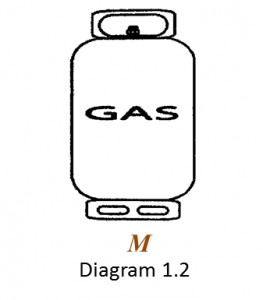Question 1:
Diagram 1.1 shows two examples of carbon compounds, K and L.

(a)(i) Based on Diagram 1.1, which one is an inorganic carbon compound? [1 mark]
(ii) State one characteristic of an inorganic carbon compound. [1 mark]
(b)(i) State one use of compound K. [1 mark]
(ii) State one effect of compound K on the nervous system if consumed excessively. [1 mark]
(c) Diagram 1.2 shows a tank containing gas M used for gas stoves.
Gas M is a hydrocarbon compound.
 (i) State two elements present in gas M. [1 mark]
(i) State two elements present in gas M. [1 mark]
(ii) State one source of gas M. [1 mark]
Answer:
(a)(i) L or marble chips
(a)(ii) Originates from non-living things or does not originates from living things
(b)(i) Alcoholic drink
(b)(ii) Disrupts nerve coordination or slows down the transmission of impulses
(c)(i)
1. Hydrogen
2. Carbon
(c)(ii) Petroleum
Diagram 1.1 shows two examples of carbon compounds, K and L.

(a)(i) Based on Diagram 1.1, which one is an inorganic carbon compound? [1 mark]
(ii) State one characteristic of an inorganic carbon compound. [1 mark]
(b)(i) State one use of compound K. [1 mark]
(ii) State one effect of compound K on the nervous system if consumed excessively. [1 mark]
(c) Diagram 1.2 shows a tank containing gas M used for gas stoves.
Gas M is a hydrocarbon compound.
 (i) State two elements present in gas M. [1 mark]
(i) State two elements present in gas M. [1 mark](ii) State one source of gas M. [1 mark]
Answer:
(a)(i) L or marble chips
(a)(ii) Originates from non-living things or does not originates from living things
(b)(i) Alcoholic drink
(b)(ii) Disrupts nerve coordination or slows down the transmission of impulses
(c)(i)
1. Hydrogen
2. Carbon
(c)(ii) Petroleum